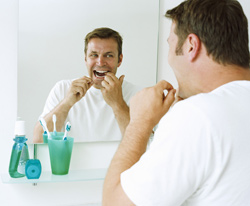Flossing That Plaque Away
While brushing removes plaque from the sides and top of your teeth, flossing is designed to remove plaque from between your teeth, the places your toothbrush just can’t reach.

Flossing once each day keeps plaque at bay!
Lots of people like to skimp on this step and the hygienist can always tell those who do because of the plaque buildup between their teeth. As with brushing, flossing is required for proper dental maintenance after a professional cleaning and examination.
Call a participating dentist near you to get it all started and they’ll show you exactly how to floss your teeth – the proper way!
What’s All the Fuss About Flossing?
Flossing removes the plaque buildup between teeth that brushing alone can’t do. If plaque is allowed to remain on tooth surfaces between your teeth, it quickly changes to tartar which can only be removed by a professional cleaning. Flossing, at least once a day, eliminates the plaque so it never turns into tartar.
Dental floss comes in waxed and unwaxed varieties. Many people prefer the waxed because it slides more easily and doesn’t shred on ragged parts of teeth or old fillings. Some people also prefer the pre-loaded dental floss on disposable plastic handles, especially if they have problems handling the floss around their teeth.
Keep in mind that if you are new at flossing your teeth, some bleeding is likely to occur at first. This is not cause for concern and the bleeding will stop as you continue to floss.
Proper Flossing Technique
Follow these steps to become an expert flosser!
- Take a length of dental floss about 18 inches long.
- Wrap the floss around the middle finger of both hands, leaving two – three inches in the middle to work with.
- Grasp the middle section with the index finger on both hands and gently slide the floss between your teeth and wrap it into a “C” shape.
- Slide the floss down into the space between the tooth and gum and gently up the sides of each tooth to remove any plaque on the tooth surfaces and at the gum line.
- Move from tooth to tooth, using a new section of floss as you go; don’t forget the back side of the last teeth!
When to Floss
It doesn’t seem to matter whether you floss your teeth before or after you brush as long as you floss! Flossing before bed is often the best bet as it allows you to remove the plague that has built up during that day, leaving you with a cleaner mouth for sleeping!
The bottom line is this – it doesn’t matter when you floss, it only matters that you floss your teeth and that you don’t rush through it. Give it the time it deserves, and your teeth and gums will thank you.

